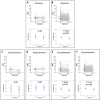Evaluation of intravitreal topotecan dose levels, toxicity and efficacy for retinoblastoma vitreous seeds: a preclinical and clinical study
- PMID: 33972235
- PMCID: PMC8788260
- DOI: 10.1136/bjophthalmol-2020-318529
Evaluation of intravitreal topotecan dose levels, toxicity and efficacy for retinoblastoma vitreous seeds: a preclinical and clinical study
Abstract
Background: Current melphalan-based intravitreal regimens for retinoblastoma (RB) vitreous seeds cause retinal toxicity. We assessed the efficacy and toxicity of topotecan monotherapy compared with melphalan in our rabbit model and patient cohort.
Methods: Rabbit experiments: empiric pharmacokinetics were determined following topotecan injection. For topotecan (15 μg or 30 µg), melphalan (12.5 µg) or saline, toxicity was evaluated by serial electroretinography (ERG) and histopathology, and efficacy against vitreous seed xenografts was measured by tumour cell reduction and apoptosis induction.
Patients: retrospective cohort study of 235 patients receiving 990 intravitreal injections of topotecan or melphalan.
Results: Intravitreal topotecan 30 µg (equals 60 µg in humans) achieved the IC90 across the rabbit vitreous. Three weekly topotecan injections (either 15 µg or 30 µg) caused no retinal toxicity in rabbits, whereas melphalan 12.5 µg (equals 25 µg in humans) reduced ERG amplitudes 42%-79%. Intravitreal topotecan 15 µg was equally effective to melphalan to treat WERI-Rb1 cell xenografts in rabbits (96% reduction for topotecan vs saline (p=0.004), 88% reduction for melphalan vs saline (p=0.004), topotecan vs melphalan, p=0.15). In our clinical study, patients received 881 monotherapy injections (48 topotecan, 833 melphalan). Patients receiving 20 µg or 30 µg topotecan demonstrated no significant ERG reductions; melphalan caused ERG reductions of 7.6 μV for every injection of 25 µg (p=0.03) or 30 µg (p<0.001). Most patients treated with intravitreal topotecan also received intravitreal melphalan at some point during their treatment course. Among those eyes treated exclusively with topotecan monotherapy, all eyes were salvaged.
Conclusions: Taken together, these experiments suggest that intravitreal topotecan monotherapy for the treatment of RB vitreous seeds is non-toxic and effective.
Keywords: animal models; efficacy; intravitreal chemotherapy; pharmacokinetics; retinoblastoma; topotecan; toxicity; vitreous seeds.
© Author(s) (or their employer(s)) 2022. Re-use permitted under CC BY-NC. No commercial re-use. See rights and permissions. Published by BMJ.
Conflict of interest statement
Competing interests: ABD and DLF have a patent with Vanderbilt University Medical Center. ABD has received research funding from Spectrum Pharmaceuticals (now Acrotech Biopharma) through an investigator-initiated study separate from the data presented in this manuscript. None of the other authors has any conflicts of interest or financial disclosures.
Figures





Similar articles
-
Intravitreal HDAC Inhibitor Belinostat Effectively Eradicates Vitreous Seeds Without Retinal Toxicity In Vivo in a Rabbit Retinoblastoma Model.Invest Ophthalmol Vis Sci. 2021 Nov 1;62(14):8. doi: 10.1167/iovs.62.14.8. Invest Ophthalmol Vis Sci. 2021. PMID: 34757417 Free PMC article.
-
Intravitreal melphalan hydrochloride vs propylene glycol-free melphalan for retinoblastoma vitreous seeds: Efficacy, toxicity and stability in rabbits models and patients.Exp Eye Res. 2021 Mar;204:108439. doi: 10.1016/j.exer.2021.108439. Epub 2021 Jan 11. Exp Eye Res. 2021. PMID: 33444583 Free PMC article.
-
Local and systemic toxicity of intravitreal melphalan for vitreous seeding in retinoblastoma: a preclinical and clinical study.Ophthalmology. 2014 Sep;121(9):1810-7. doi: 10.1016/j.ophtha.2014.03.028. Epub 2014 May 10. Ophthalmology. 2014. PMID: 24819859
-
Eye-preservation treatment of retinoblastoma with vitreous seeding.Jpn J Clin Oncol. 2003 Dec;33(12):601-7. Jpn J Clin Oncol. 2003. PMID: 14769836 Review.
-
Therapy for Vitreous Seeding Caused by Retinoblastoma. A Review.Cesk Slov Oftalmol. 2024;80(3):123-129. doi: 10.31348/2023/35. Cesk Slov Oftalmol. 2024. PMID: 38538290 Review. English.
Cited by
-
Intravitreal HDAC Inhibitor Belinostat Effectively Eradicates Vitreous Seeds Without Retinal Toxicity In Vivo in a Rabbit Retinoblastoma Model.Invest Ophthalmol Vis Sci. 2021 Nov 1;62(14):8. doi: 10.1167/iovs.62.14.8. Invest Ophthalmol Vis Sci. 2021. PMID: 34757417 Free PMC article.
-
Complete preclinical platform for intravitreal chemotherapy drug discovery for retinoblastoma: Assessment of pharmacokinetics, toxicity and efficacy using a rabbit model.MethodsX. 2021 Apr 20;8:101358. doi: 10.1016/j.mex.2021.101358. eCollection 2021. MethodsX. 2021. PMID: 34430259 Free PMC article.
-
Advanced Interventional Treatments in Retinoblastoma Management: A Comprehensive Review.Cardiovasc Intervent Radiol. 2024 Apr;47(4):407-415. doi: 10.1007/s00270-024-03692-2. Epub 2024 Mar 20. Cardiovasc Intervent Radiol. 2024. PMID: 38509339 Review.
-
Update on Retinoblastoma Therapies.Medicina (Kaunas). 2025 Jul 4;61(7):1219. doi: 10.3390/medicina61071219. Medicina (Kaunas). 2025. PMID: 40731848 Free PMC article. Review.
-
Aqueous VEGF-A Levels as a Liquid Biopsy Biomarker of Retinoblastoma Vitreous Seed Response to Therapy.Invest Ophthalmol Vis Sci. 2024 Jun 3;65(6):18. doi: 10.1167/iovs.65.6.18. Invest Ophthalmol Vis Sci. 2024. PMID: 38861274 Free PMC article.
References
Publication types
MeSH terms
Substances
Grants and funding
LinkOut - more resources
Full Text Sources
Other Literature Sources
Medical
Miscellaneous
